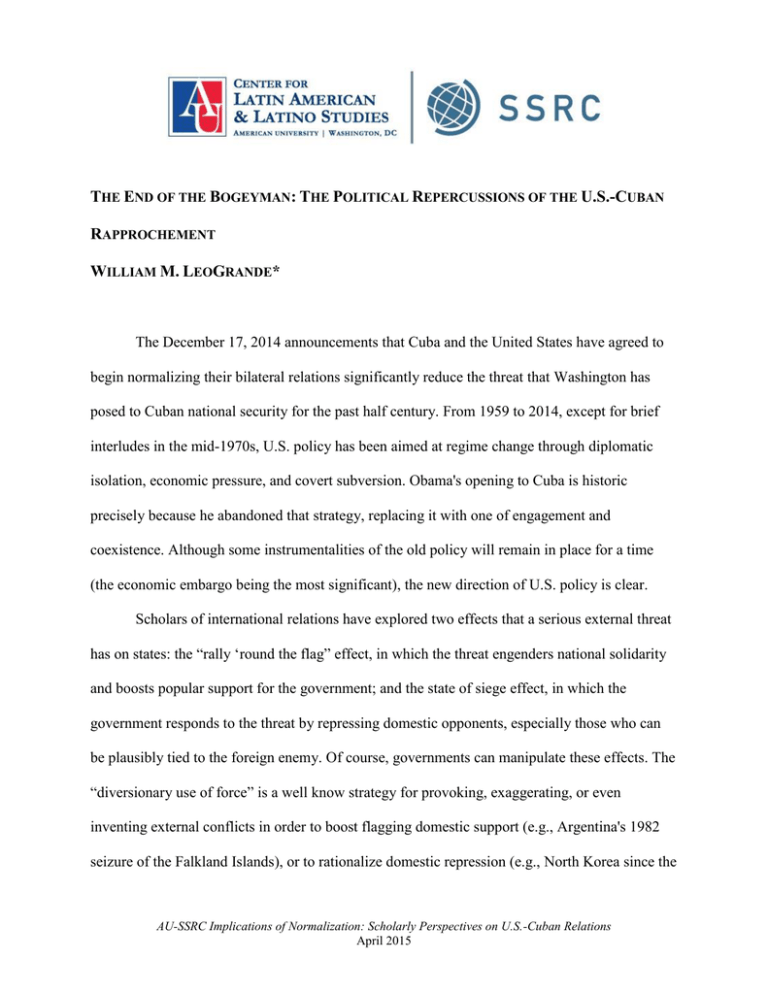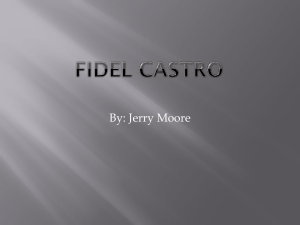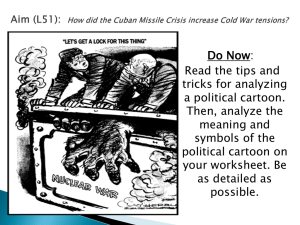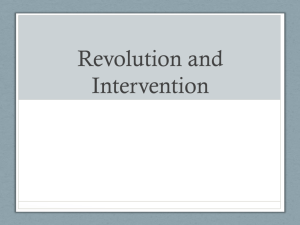T E B :
advertisement

THE END OF THE BOGEYMAN: THE POLITICAL REPERCUSSIONS OF THE U.S.-CUBAN RAPPROCHEMENT WILLIAM M. LEOGRANDE* The December 17, 2014 announcements that Cuba and the United States have agreed to begin normalizing their bilateral relations significantly reduce the threat that Washington has posed to Cuban national security for the past half century. From 1959 to 2014, except for brief interludes in the mid-1970s, U.S. policy has been aimed at regime change through diplomatic isolation, economic pressure, and covert subversion. Obama's opening to Cuba is historic precisely because he abandoned that strategy, replacing it with one of engagement and coexistence. Although some instrumentalities of the old policy will remain in place for a time (the economic embargo being the most significant), the new direction of U.S. policy is clear. Scholars of international relations have explored two effects that a serious external threat has on states: the “rally ‘round the flag” effect, in which the threat engenders national solidarity and boosts popular support for the government; and the state of siege effect, in which the government responds to the threat by repressing domestic opponents, especially those who can be plausibly tied to the foreign enemy. Of course, governments can manipulate these effects. The “diversionary use of force” is a well know strategy for provoking, exaggerating, or even inventing external conflicts in order to boost flagging domestic support (e.g., Argentina's 1982 seizure of the Falkland Islands), or to rationalize domestic repression (e.g., North Korea since the AU-SSRC Implications of Normalization: Scholarly Perspectives on U.S.-Cuban Relations April 2015 1953 armistice). But what happens when a long-standing foreign threat that has produced both these effects suddenly disappears? That is the situation faced today by Cuba. Although the normalization of relations with the United States is still at its earliest stages, the jubilant reaction of the Cuban population to the December 17 announcements clearly indicates that they interpret the new opening as having ended the cold war in the Caribbean. Without the U.S. threat, will national unity be harder to maintain? Will the public be less willing to accept constraints on political liberties in the name of national security? Rallying 'round the Flag One of Fidel Castro's great gifts as a politician was his ability to grasp the core values of Cuban political culture and, through his oratory, reflect them back to the public in ways that resonated deeply. Perhaps the most important of these values was nationalism. Having won independence three quarters of a century after the rest of Latin America, only to have its sovereignty hamstrung by the U.S.-imposed Platt Amendment, Cuba's nationalist sentiment has been especially strong. Castro appealed to that sentiment during the insurrection against Fulgencio Batista, but even more so after the triumph of the revolution as his new government confronted the United States. Fidel understood very well the political value of mobilizing Cuban nationalism behind his radical program. After one speech featuring especially harsh anti-American rhetoric, Castro encountered the Chargé d'Affaires of the U.S. embassy, Daniel M. Braddock, and said he hoped Washington “had received no hurt [from his speech] as he had intended none,” but that it was “necessary in a public rally of that sort to express certain points of view.”i 2 Speaking two years later, Castro extolled the virtue of confrontation. “The Revolution has to fight; combat is what makes revolutions strong,” he said in early 1961. “A revolution that does not confront an enemy runs the risk of falling asleep, of growing weak.... Like armies hardening themselves, revolutions need to confront an enemy!”ii As U.S.-Cuban relations deteriorated in 1959-1960, Washington obligingly provided that enemy. Some Eisenhower administration officials warned that open conflict would enhance Castro's political support. “We cannot expect patriotic and self-respecting Cubans, no matter how distasteful Castro's policies may be to them, to side with the United States,” State Department official John Calvin Hill argued, “if we go so far along the lines of reprisals that the quarrel no longer is between Castro and the real interests of the Cuban people but a quarrel between the United States and their country.”iii In August 1961, during the founding meeting of the Alliance for Progress in Punta del Este, Uruguay, Che Guevara arranged a private meeting with Richard Goodwin, a White House aide to President John F. Kennedy. Che wanted to explore the possibility of a modus vivendi between Cuba and the United States in the aftermath of the Bay of Pigs. But he began by thanking Goodwin for the invasion. “Their hold on the country had been a bit shaky,” Goodwin wrote to Kennedy in his trip report, “but the invasion allowed the leadership to consolidate most of the major elements of the country around Fidel.”iv The Bay of Pigs enabled Castro to wrap the revolution's socialist agenda in the flag of Cuban nationalism. Through the years, Castro proved adept at using confrontations with Washington to mobilize support. In 1964, he made a cause célèbre of Cuban fisherman detained by the U.S. Coast Guard for fishing in U.S. waters. In 2000, he used the campaign to return six-year old Elián González to reinvigorate flagging revolutionary enthusiasm. For nearly a decade, demands 3 for the release of the “Five Heroes” (the five Cuban spies imprisoned in the United States since 1998) boosted national solidarity. And for half a century, Cuba’s leaders have been able to blame the nation’s economic problems on the U.S. embargo (although Raúl Castro has resorted to that excuse much less often than his older brother did). What will happen now that the U.S. threat is diminishing? “En la calle,” expectations are running high that rapprochement means the embargo will end and daily life will get better. In reality, the new turn in U.S.-Cuban relations is unlikely to have a major economic impact any time soon, so the government has been working to dampen expectations. A long interview with Cuban diplomat Josefina Vidal in Granma emphasized that the embargo is still in place.v But it will be tough to get the genie of heightened popular expectations back in the bottle. If Raúl Castro’s “updating” of the Cuban economy does not soon begin to raise the standard of living for ordinary people, they will be even more apt to blame their government rather than the United States. Or, as U.S. diplomat Roberta Jacobson put it, “The bogeyman of the U.S. being their problem—it’s no longer credible.”vi State of Siege States facing existential threats from abroad are notorious for repressing dissent at home in the name of national security, and many constitutions provide for the suspension of basic liberties during national emergencies. In Cuba, the very real threat of attack by the United States in the early years of the revolutionary government, combined with Fidel Castro’s intolerance of opposition, produced an authoritarian single-party system justified both by Cuban political tradition and by the immediacy of the U.S. threat. Castro’s insistence on national unity was rooted in Cuban political culture. The first war 4 of independence was lost in 1878 when one wing of the insurgent army signed a separate peace with Spain. José Martí, the father of Cuban independence, insisted on forging one single revolutionary party in 1895. At its Fifth Congress in 1997, the Cuban Communist Party published a justification for its monopoly on power not by invoking Lenin, but by invoking Martí. “The great lesson has emerged out of our own historical experience: without unity, revolutionaries and the people can achieve nothing in their struggle,” the document declared, and unity required, as in the time of Martí, a single party to prevent the United States from reimposing neocolonial capitalism on Cuba.vii Since the earliest years of the revolution, domestic opponents have been branded as agents of the United States and thus as enemies of the revolution. “All criticism is opposition,” Castro wrote to compatriot Carlos Franqui, “All opposition is counterrevolutionary.”viii Too often, Washington has given the Cuban government a ready-made justification for its intolerance by actively recruiting and supporting domestic opponents as part of its regime-change strategy. In 2003, when the government imprisoned 75 dissidents, they were charged not with dissent per se, but with acting in concert with the United States. What will happen now that Washington has replaced the policy of regime change with one of coexistence and engagement? To be sure, the U.S. “democracy promotion” programs aimed at stimulating opposition in Cuba have not disappeared and will likely remain for some time. But they are no longer part of an overall policy of hostility that Cuba can point to as justification for suppressing opposition. Will the reduction of the external threat lead to greater political openness on the island? The dissidents who have endorsed Obama's policy hope and expect that it will, as do many non-dissident intellectuals. But after fifty years of top-down politics, it may be a hard transition for Cuba's leaders to 5 make. “It's difficult enough to prepare for a war,” said former Cuban diplomat Carlos Alzugaray, “How can you prepare for a declaration of peace? The idea of a siege mentality is embedded here.”ix In 1961, Fidel Castro famously defined the limits of debate when he declared, “Within the revolution, everything; against the revolution, nothing.”x For the last several years, Cuba’s intelligentsia has been successfully pushing out the boundaries of debate in culture, economic policy, and politics. As the U.S. threat recedes, they are certain to push harder to expand the limits of what is “within the revolution.” And without the bogeyman of the United States, Cuban leaders will have a much weaker rationale for resisting. *William M. LeoGrande is Professor of Government at American University in Washington, DC. and coauthor with Peter Kornbluh of the recent book, Back Channel to Cuba: The Hidden History of Negotiations between Washington and Havana (University of North Carolina Press, 2014). i. U.S. Department of State, Office of the Historian. 1991. Foreign Relations of the United States, 1958-1960, Vol. VI, Cuba, Doc. 238: 381. Washington, D.C.: Government Printing Office. ii. Castro, Fidel. 1961. “Discurso Pronunciado por el Comandante Fidel Castro Ruz, en el Acto de Inauguración de la Ciudad Escolar ‘Abel Santamaría,’ en la Ciudad de Santa Clara, el 28 de Enero de 1961,” in Discursos e intervenciones del Comandante en Jefe Fidel Castro Ruz. Available at http://www.cuba.cu/gobierno/discursos/ (Authors’ translation). iii. U.S. Department of State. Foreign Relations of the United States, 1958-1960, Vol. VI, 6 Cuba, Doc 473, Tab D: 830-832. iv. LeoGrande, William M., and Peter Kornbluh. 2014. Back Channel to Cuba: The Hidden History of Negotiations between Washington and Havana. Chapel Hill: University of North Carolina Press. v. Escobar, Cristina. 2015. “The Blockade Has Not Ended.” Granma International, February 12. vi. Hearing of the House Foreign Affairs Committee. 2015. “Cuba: Assessing the Administration's Sudden Shift.” Federal News Service, February 4. vii. Partido Comunista de Cuba. 1997. El Partido de La Unidad, La Democracia y Los Derechos Humanos Que Defendemos: V Congreso del Partido Comunista de Cuba, La Habana, 8-10 de Octubre de 1997. Havana: Editora Política. viii. Bardach, Anne Louise. 2003. Cuba Confidential: Love and Vengeance in Miami and Havana. New York: Vintage. p. 280. ix . DeYoung, Karen. 2015. “As Talks with U.S. Begin, Cubans Anticipate Changes in Their Lives.” Washington Post, January 25. x. Castro, Fidel. 2008. “Words to Intellectuals, June 30, 1961.” In Fidel Castro Reader. North Melbourne, Australia: Ocean Press. p. 220. 7






